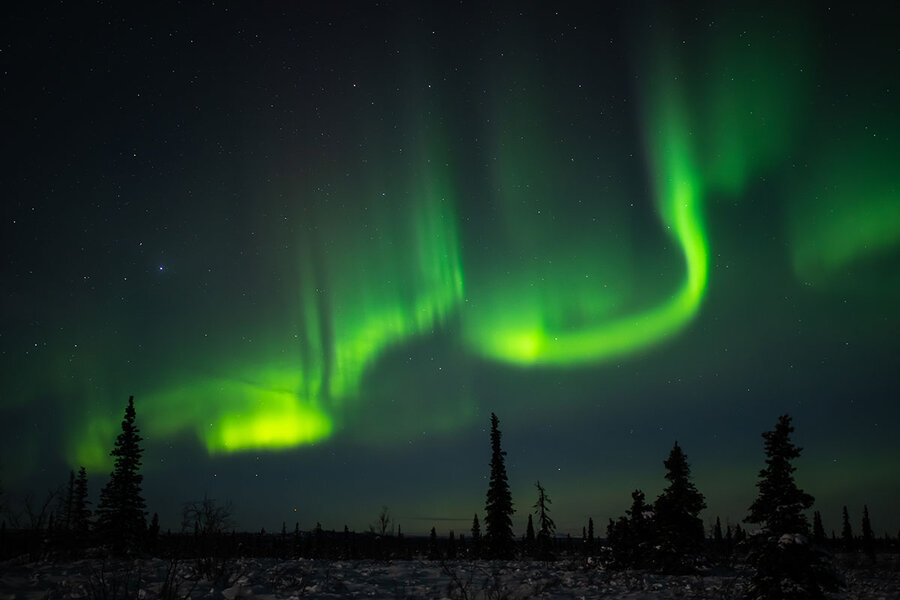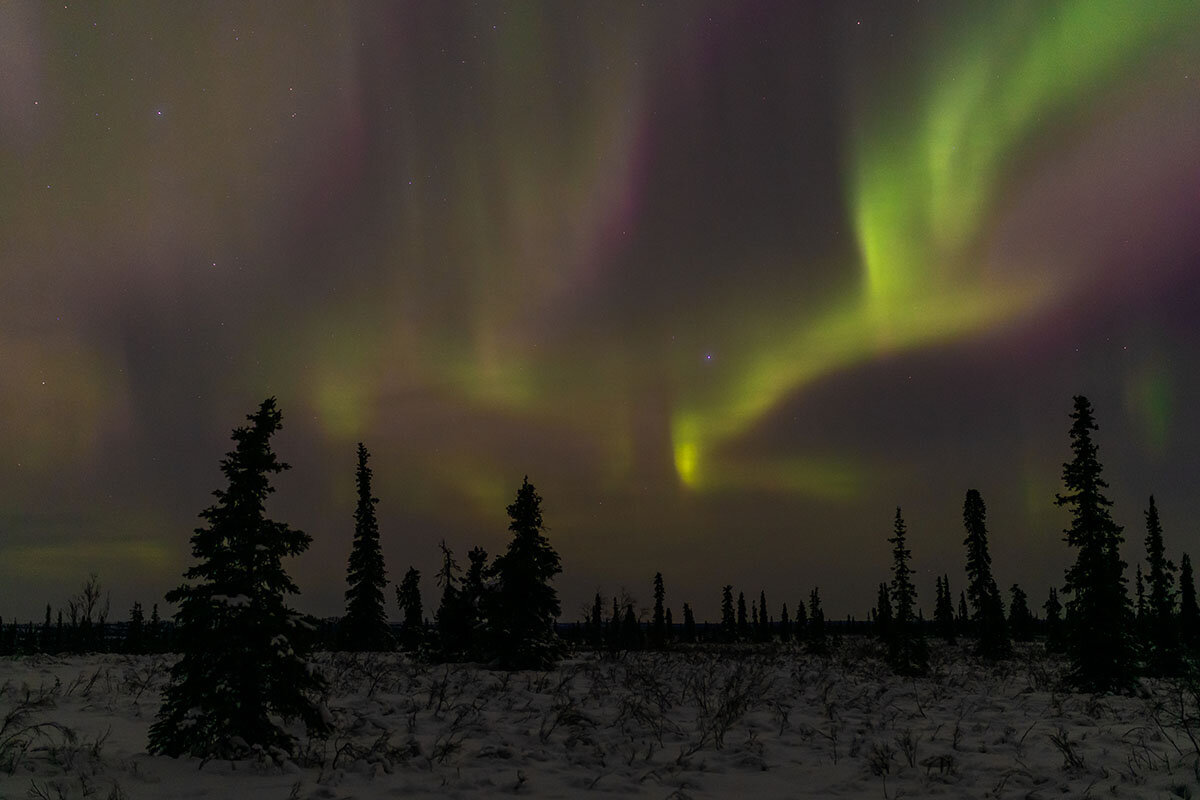Cold journey. Lasting joy. My trek to see the northern lights.
Loading...
| Just past Eureka Roadhouse, Alaska
It’s getting close to midnight, and close to my destination – mile marker 133 on Alaska’s Glenn Highway, where I’m on the road to fulfilling a lifelong dream. Tonight, if the forecast app and my guide are correct, I’m going to see the northern lights. The aurora borealis.
When we at last pull over at the designated spot, we are on the edge of a giant meadow. Only scattered evergreens stand between us and the horizon. No light pollution. No mountains to block the view.
Why We Wrote This
A story focused onOur reporter treks through Alaska to see the aurora borealis. Her journey takes her though dark and cold, for a fleeting splendor of light that leaves a lasting joy.
“I can’t tell you how much joy I get from seeing the smile on people’s faces,” says my guide, Scott Stansbury of SSP Studio & Gallery. “That’s the reason I do tours.”
Eventually, the lights appear, then grow more glorious each time I step outside. Finally, as if playing a visual symphonic encore, a giant streak of phosphorous green seems to swoop down to the treetops and dollop them with a curlicue swirl. I’m smiling inside and out.
It’s getting close to midnight, and close to my destination – mile marker 133 on Alaska’s Glenn Highway, where I’m on the road to fulfilling a lifelong dream. Tonight, if the forecast app and my guide are correct, I’m going to see the northern lights. The aurora borealis.
More than two hours ago, aurora tour operator Scott Stansbury of SSP Studio & Gallery picked me up at the Hotel Captain Cook in Anchorage. We cleared the city’s exurbs, and then began a long, lonely, and careful drive in the dark, the headlights of his new Kia minivan cutting a tunnel through black forest, his studded snow tires gripping the icy road with assurance.
As we wind through mountains, a moose suddenly comes into view by the side of the road. Then two more! Later, Scott points to his dashboard thermometer. It’s minus 24 degrees outside. A microclimate. It won’t be that cold when we get there, he promises. Finally, up ahead, Christmas lights twinkle on the left. This is Eureka Roadhouse. Two gas pumps (closed in winter), a population of two dozen, and just a few miles from marker 133.
Why We Wrote This
A story focused onOur reporter treks through Alaska to see the aurora borealis. Her journey takes her though dark and cold, for a fleeting splendor of light that leaves a lasting joy.
When we at last pull over at the designated spot, we are on the edge of a giant meadow. Only scattered evergreens stand between us and the horizon. No light pollution. No mountains to block the view. I am Scott’s only client tonight, but whether it’s one person or a bridal party from Japan, the professional photographer and videographer loves to come out here to witness one of nature’s most spectacular shows – and to share it with others.
“I can’t tell you how much joy I get from seeing the smile on people’s faces. That’s worth it right there. That’s the reason I do tours,” he says in his upbeat Texas tones. They seem incongruous this far north, until you remember that most Alaskans come from somewhere else.
I emerge from the van into minus 6 degrees, bundled like the Michelin Man. A bazillion stars sparkle, and the Milky Way pours overhead. What looks like a gray stream of cloud arcs low over the horizon. “That’s it!” says Scott.
Really? That’s it? I spent 13 hours in planes and airports, and then drove 2.5 hours to see a gray streak? “Patience,” he says, good-naturedly. It will get better. Wait till 2 a.m. That’s usually the best time.
He encourages me to get back into the toasty van, which he leaves running, and go to sleep (he provides blankets, pillows, and tilt-back seats). With a Wi-Fi hot spot in his vehicle, he’s got plenty of work to do from his phone. “I’ll wake you when something happens.”
Dog sledding and aurora
Aurora tourism is a growing niche industry in arctic climes. Often it’s combined with winter activities like mushing, ice fishing, snow machine rides, and hot springs. Every year, thousands of tourists stream to Alaska in search of night skies dancing with neon green and other colors caused when electrically charged particles from solar wind collide with molecules and atoms of gas in Earth’s atmosphere.
The heavenly ballet can be seen at Earth’s magnetic poles when it’s dark and skies are clear. Some of the best viewing spots include Fairbanks, Alaska (the area’s viewing season runs Aug. 21-April 21); Canada’s Dawson City, Yellowknife, and Gillam; the southern tip of Greenland; Reykjavik, Iceland; Tromsø, Norway; and the northern coast of Siberia, according to the Geophysical Institute at University of Alaska Fairbanks. The institute’s “aurora forecast” webpage is a great place to learn more about the science of the northern lights and when and how to see them.
Pandemic travel restrictions put aurora tourism in a deep freeze for two years. While business is not yet back to pre-pandemic levels, it’s “going well,” says Kathy Hedges, marketing coordinator for Northern Alaska Tour Co. in Fairbanks, which she describes as the longest-running tour operator in Alaska’s Arctic. The company operates year-round, though the aurora is the main draw in winter.
As aurora guides and scientists will tell you, there’s no guarantee of a sighting. But Fairbanks is a statistically good bet because of its northern location and freedom from coastal clouds, which can be a challenge for Anchorage. Ms. Hedges and others recommend putting aside at least three nights to improve your chances of viewing, with the idea that you’ll be up much of the night each time.
“On its surface, looking for aurora is boring,” she admits. “You stand there, waiting, waiting, waiting.” That’s why companies offer additional activities and packages. Hers includes visiting the Alaska pipeline and dog sledding with a local musher. You can book a one-day drive to a homestead called Joy, or a multinight stay at Coldfoot, above the Arctic Circle.
“About to bust loose”
Scott is proud of his aurora record. He’ll cancel when it’s bad weather or a poor aurora forecast, but on his go nights, he says, “I’ve only been skunked twice in five years.”
He’s got three preferred spots far from Anchorage, and he researches aurora conditions before confirming a trip – including checking with locals to see what they’re observing. He came recommended by the Cook Hotel’s concierge, and his services include photographs of your experience as part of the package.
On the way up, he was checking an aurora app on his phone. “It’s about to explode on us!” he exults. “It’s about to bust loose!”
And eventually, it does. Each time he wakes me and I step outside, it appears more glorious. At first, a honeydew fuzz skitters along the horizon. Another time, a broad green stripe stretches across the sky, anchored by a short tail. “Do you see the red?” Scott asks. He has me look through his camera. It can see more color than the naked eye. When we watch aurora spikes that resemble a picket fence, he tells me those are called “STEVEs.”
Finally, as if playing a visual symphonic encore, a giant streak of phosphorous green seems to swoop down to the treetops and dollop them with a curlicue swirl. I’m smiling inside and out. We can go now.










